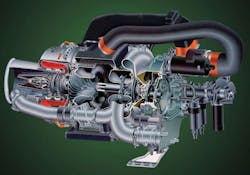Asiana Airlines selects Honeywell auxiliary power units to help improve aircraft performance, reduce maintenance costs for A320, A321, and A321neo
SINGAPORE. Asiana Airlines officials in Seoul, South Korea, need a reliable and efficient power source to start aircraft main engines and run air conditioning while the plane is on the ground. They found their solution at Honeywell (NYSE:HON) in Singapore. With Honeywell's auxiliary power units (APUs), Asiana Airlines can improve operational performance and lower maintenance costs over the life cycle of its fleet to achieve significant fuel savings year over year, officials say.
An auxiliary power unit (APU) is a critical aircraft component that provides primary or backup electrical power for environmental, cockpit, and hydraulic systems during flight.
Honeywell will supply its 131-9A APUs to 74 Asiana Airlines aircraft, of which 49 will be retrofitted on the airline's existing Airbus A320ceo (current engine option) and A321ceo fleet, and the remaining 25 on its new Airbus A321neo fleet. The 131-9A series helps reduce delays and flight cancellations to keep airlines on schedule and ensure their passengers reach their destinations on time. The retrofit program for the Airbus A320ceo and A321ceo fleet will run from 2017 until 2020, while delivery for the new Airbus A321neo fleet is scheduled from 2019 until 2025.
"As demand for air travel in the Asia Pacific region increases, it is crucial for airlines to remain competitive by balancing a smooth, on-time flight experience for passengers with reduced operational costs to boost the bottom line," says Dong-Jun Shin, general manager, aircraft & supplies purchasing, Asiana Airlines. "We are confident that Honeywell, which has more than 50 years of proven reliability developing APUs, will help us achieve this balance."
"In today's highly competitive airline industry, companies like Asiana Airlines need to increase the cost efficiency of maintenance services, while ensuring safety and reliability are not compromised," says Brian Davis, vice president, airlines, Asia Pacific, Honeywell Aerospace. "We are committed to understanding our customers' specific challenges, and we are confident that our 131-9A APUs will help Asiana Airlines and others improve their fleet availability."
Honeywell will provide Asiana Airlines with a global network of maintenance services from its local customer support team based in South Korea, together with an established APU maintenance facility in Singapore that has a strong, longstanding relationship with Asiana Airlines. In March 2017, Airbus designated the Honeywell 131-9A APU as standard equipment for its A320 family of aircraft. Honeywell's APU is now recognized as the gold standard for the A320 family.
Honeywell invented the first APU in 1948 and is still the largest producer of gas turbine engines globally. The company has produced more than 95,000 APUs and has more than 36,000 in service today across more than 150 regional, executive, commercial and military applications, including both fixed-wing and rotary-wing aircraft.
Honeywell recently shipped its 5,000th 131-9A APU, putting the number of production APUs from the 131-9 family at more than 11,000 units, with more than 100 million total flight hours. The 131-9 series APU has been selected by airlines for the majority of narrow-body aircraft and features a unique electronic control box that integrates advanced, plain-English troubleshooting logic and health-monitoring capabilities for intuitive maintenance. This helps increase its already proven reliability to reduce delays and flight cancellations, allowing airlines to stay on schedule so their passengers can reach their destinations on time.
Search the Aerospace & Defense Buyer's Guide
The go-to resource for Intelligent Aerospace technology news & information:
Covering key topics
Across all market segments
Subscribe to the free Intelligent Inbox e-newsletter
Subscribe to receive all the latest aerospace technology news & information, delivered directly to your e-mail inbox twice a week (Tuesdays and Thursdays). Sign upfor your free subscription to the Intelligent Inbox e-newsletter at http://www.intelligent-aerospace.com/subscribe.html.
Connect on social media
Keep pace with aerospace innovation and opportunities via your favorite social media channels. Connect with Intelligent Aerospace on Twitter (@IntelligentAero), LinkedIn,Google+, and Instagram.
Intelligent-Aerospace.com


